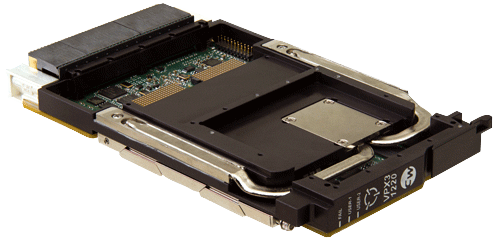
By Courtney Howard
Excerpts below from article published in Military & Aerospace Electronics
Military and aerospace requirements demand greater strength, speed, and capabilities in smaller form factors.
Aerospace and defense vehicles and electronics are shrinking in both size and weight, while system requirements continue to expand over time. Greater demands are being placed on increasingly compact platforms and systems, as a wealth of military and aerospace applications, move to small-form-factor (SFF) embedded computers.
3U from 6U
Traditionally, 6U has been the standard form factor for a majority of commercial off-the-shelf (COTS) electronics in aerospace and defense. Technology refresh is enabling miniaturization, making the 3U form factor a popular choice.
"You can now get on a 3U board what used to take multiple 6U boards," says Aaron Frank, product manager, COTS Solutions at Curtiss-Wright Defense Solutions in Ottawa. "3U is better than 6U from a thermal-management perspective because components are almost always closer to an edge and, in a conduction-cooled environment, the closer you are to the edge of the board, the better the thermal cooling solution."

Curtiss-Wright OpenVPX and XMC processor modules are tailored to aerospace & defense.
Frank is seeing increased demand for 3U designs across the board, but primarily in ground and air environments. "Where they used to have one box that handled single or dual functions, they now have the need for many more functions onboard a single platform," he says. "For that reason, customers are trying to consolidate space and put many different pieces of equipment in the same space where a single- or dual-function box used to reside. That's helping to drive smaller-form-factor boards and packaging to meet those needs.
"A perfect example of being able to do more with 3U today, Curtiss-Wright was successful in designing a 3U board that had all the functionality of two to three 6U boards in a 3U space by taking advantage of advances in microelectronics, miniaturization, and the latest printed circuit board (PCB) design rules and technologies without sacrificing any performance or reliability of an extremely rugged design," Frank describes.
"The board uses an XMC mezzanine card that packs all the punch of what's also integrated on the 3U host," Frank says. The XMC card can be added to any existing 3U board to double the performance and functional density. "In other words, the power of two 3U cards can be put into a single slot using this XMC approach." The design helped Curtiss-Wright win first place in the military and aerospace design excellence category at the 27th Annual PCB Technology Leadership Awards by Mentor, a Siemens Business.
Small size can bring power benefits, recognizes Mike Southworth, product manager at Curtiss-Wright Defense Solutions in Salt Lake City. A platform may have constraints because of the payloads onboard, he says. "In the case of a platform with an intelligence, surveillance, and reconnaissance (ISR) mission, there may be a number of sensors onboard and networks for Ethernet and processors that are taking data from the sensors and doing something with that data."
The smaller the onboard computers can be, the better, Southworth says. "It is to the advantage of the platform because it reduces the demands for fuel, enabling longer flight times if the platform is an aircraft, or extend battery life if it's a ground or surface vehicle. That can translate into lower power consumption as well, because you're dealing with smaller devices. So there are benefits from a power-management standpoint.
"The caveat is that the smaller [a system gets], the more concerned you should be about thermal management," Southworth continues. "The performance often needs to be balanced against what you can effectively cool. So there is a tipping point as far as what thermal management can do based on the performance out of the box."
Scalability and I/O Flexibility
"The smaller the form factor, the less backplane slots and less I/O interface capabilities in terms of how many additional cards that can be integrated into the I/O architecture," Curtiss-Wright's Southworth says. SFF standards for I/O cards provide some level of flexibility, he adds, noting that PCI Express or PCIe-104 standards-based I/O cards are fairly small and enable the integration of a considerable amount of SFF functionality.
At the same time, Southworth says, "the interconnect building blocks for signals inside and outside of SFF systems are being miniaturized, allowing us to shrink the footprint of the box. Often, in the past, the size of the box was driven by the connector's shell size and now there's miniaturized versions of the most popular military connector types - that allows those boxes to shrink in size."
With SFF subsystems, it's easier to break the solution into multiple boxes, placing the processing in one box and the I/O in another, for example, says Curtiss-Wright Defense Solutions Chief Technology Officer (CTO) David Jedynak in Austin, Texas. "That way you can avoid having to have all the I/O in a single box. Instead of having one box that has the entire 'kitchen sink' in it, doubling the I/O and increasing the unit size and connector counts, you can achieve benefits by going with multiple SFF units."
ISR Innovation
SFF enables much more intelligence to be added to platforms that previously would have had very little onboard, Curtiss-Wright's Jedynak explains. "For example, smaller deployed platforms, like UAVs, which didn't previously have the ability to host significant amounts of processing, now can. Customers see that smaller, more powerful rugged computers are now available, and that's encouraging them to think of innovative ways to use and deploy them."
New types of smaller platforms that didn't exist before are helping to drive demand for SFF, such as UAVs designed for use in swarm applications, Jedynak says. "That type of application was not possible before the emergence of the new classes of SFF embedded computers and network switches."
Missile Defense
Ruggedization is a requirement for missile defense and a growing number of other SFF applications. "Don't get seduced by solutions that weren't designed from the ground up to operate in the harsh environments typical of military and aerospace applications," Southworth cautions. "Not all SFF computers are designed equally. Select SFF solutions that are qualified to the types of rigorous requirements typical of deployed platforms."
Read the full article here.